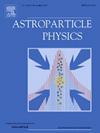A systematic assessment of Data Volume Reduction for IACTs
IF 2.9
3区 物理与天体物理
Q1 ASTRONOMY & ASTROPHYSICS
引用次数: 0
Abstract
High-energy cosmic rays generate air showers of secondary particles when they enter the Earth’s atmosphere. These highly energetic particles emit Cherenkov light that can be detected by Imaging Air Cherenkov Telescopes (IACTs) or Water-Cherenkov Detectors at mountain altitudes. Advances in the technique and larger collection areas have increased the rate at which air shower events can be captured, and the amount of data produced by modern high-time-resolution Cherenkov cameras. Therefore, Data Volume Reduction (DVR) has become critical for such telescope arrays, ensuring that only relevant information regarding the air shower is stored long-term. Given the vast amount of raw data, owing to the highest resolution and sensitivity, the upcoming Cherenkov Telescope Array Observatory (CTAO) will need robust data reduction strategies to ensure efficient data handling and a sustainable data analysis. The CTAO data rates needs to be reduced from hundreds of Petabytes (PB) per year to a few PB/year.
This paper presents DVR algorithms tailored for CTAO but also applicable for other existing IACT arrays, focusing on the selection of pixels likely to contain Cherenkov light from the air shower. It describes and evaluates multiple algorithms based on their signal efficiency, noise rejection, and shower reconstruction. With a focus on a time-based clustering algorithm which demonstrates a notable enhancement in the retention of low level signal pixels. Moreover, the robustness is assessed under different observing conditions, including detector defects. Through testing and analysis, it is shown that these algorithms offer promising solutions for efficient volume reduction in CTAO. They effectively address the challenges posed by the array’s very large data volume and ensure reliable data storage amidst varying observational conditions and hardware issues.
IACTs数据量减少的系统评估
高能宇宙射线进入地球大气层时会产生二次粒子的空气阵雨。这些高能粒子发出切伦科夫光,可以通过成像空气切伦科夫望远镜(IACTs)或山区的水切伦科夫探测器探测到。技术的进步和更大的收集区域增加了捕捉风淋事件的速度,以及现代高时间分辨率切伦科夫相机产生的数据量。因此,数据体积缩减(DVR)对于这样的望远镜阵列至关重要,以确保只长期存储与风淋室有关的信息。鉴于大量的原始数据,由于最高的分辨率和灵敏度,即将到来的切伦科夫望远镜阵列天文台(CTAO)将需要强大的数据精简策略,以确保有效的数据处理和可持续的数据分析。CTAO数据速率需要从每年数百PB (Petabytes)降低到几PB/年。本文提出了为CTAO定制的DVR算法,但也适用于其他现有的IACT阵列,重点是选择可能包含来自风阵雨的切伦科夫光的像素。它描述并评估了基于它们的信号效率、噪声抑制和阵雨重建的多种算法。重点介绍了一种基于时间的聚类算法,该算法在低电平信号像素的保留方面有显著的提高。此外,还评估了不同观测条件下的鲁棒性,包括检测器缺陷。通过测试和分析表明,这些算法为CTAO的高效减容提供了有希望的解决方案。它们有效地解决了阵列非常大的数据量带来的挑战,并确保在不同的观测条件和硬件问题下可靠的数据存储。
本文章由计算机程序翻译,如有差异,请以英文原文为准。
求助全文
约1分钟内获得全文
求助全文
来源期刊

Astroparticle Physics
地学天文-天文与天体物理
CiteScore
8.00
自引率
2.90%
发文量
41
审稿时长
79 days
期刊介绍:
Astroparticle Physics publishes experimental and theoretical research papers in the interacting fields of Cosmic Ray Physics, Astronomy and Astrophysics, Cosmology and Particle Physics focusing on new developments in the following areas: High-energy cosmic-ray physics and astrophysics; Particle cosmology; Particle astrophysics; Related astrophysics: supernova, AGN, cosmic abundances, dark matter etc.; Gravitational waves; High-energy, VHE and UHE gamma-ray astronomy; High- and low-energy neutrino astronomy; Instrumentation and detector developments related to the above-mentioned fields.
 求助内容:
求助内容: 应助结果提醒方式:
应助结果提醒方式:


